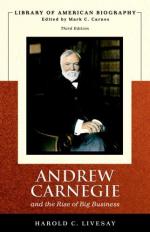
|
| Name: _________________________ | Period: ___________________ |
This quiz consists of 5 multiple choice and 5 short answer questions through The Master Manager: Costs, Chemistry, and Coke.
Multiple Choice Questions
1. A second dimension necessary to effect this integration is the implementation of what system?
(a) Welfare.
(b) Benefits.
(c) Accountability.
(d) Democratic.
2. Carnegie feels confident enough in 1870 to do what?
(a) Make large changes in the business.
(b) Sell the business.
(c) Buy new businesses.
(d) Expand the business.
3. He forms an informal investing ____________ with Thomson and Scott.
(a) Quintumvirate.
(b) Triumvirate.
(c) Duumvirate.
(d) Quadrumvirate.
4. Scott leaves Carnegie in charge when he does what?
(a) Quits.
(b) Retires.
(c) Has mandatory surgery.
(d) Takes a ten-day trip.
5. Who is Cuban Roberto Goizuetta?
(a) The deceased CEO of Intel.
(b) The deceased chairman of Applebee's.
(c) The deceased chairman of Coca-Cola.
(d) The deceased president of Liz Claiborne.
Short Answer Questions
1. In 1849 when he takes the job, Carnegie is at the beginning of a period when capital, manpower and technology in the United States transitions from __________________.
2. In __________, Carnegie has the most modern operation.
3. _____________ is the focal point that straddles the east-west route where the Monongahela and Allegheny rivers join at the Ohio River.
4. Small firms operate iron furnaces to smelt ore into _______ iron.
5. Scott and Thomson like the Woodruff Sleeping Car Company that owns patents in 1858 but lacks what?
|
This section contains 235 words (approx. 1 page at 300 words per page) |

|




